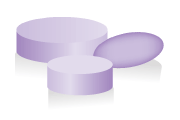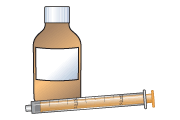Atenolol for high blood pressure
This leaflet is for parents and carers about how to use this medicine in children. Our information may differ from that provided by the manufacturers, because their information usually relates to adults. Read this leaflet carefully. Keep it somewhere safe so that you can read it again.
Atenolol can trigger asthma. Tell your doctor if your child has ever had asthma or episodes of wheezing, before giving Atenolol.
Do not stop giving Atenolol suddenly, as this may cause your child’s blood pressure to rise.
Name of medicine
Atenolol
Brand names: Tenormin
Why is it important for my child to take Atenolol?
High blood pressure (hypertension) can lead to damage to internal organs. Atenolol is a medicine called a beta blocker. It opens up blood vessels and slows the heart so that it pumps less forcefully, which help to lower the blood pressure.
What is Atenolol available as?
- Tablets: 25 mg, 50 mg, 100 mg
- Liquid medicine: 25 mg in 5 mL
When should I give Atenolol
Atenolol is usually given once each day.
If your child is taking more than one medicine to reduce their blood pressure, your doctor may suggest that they take the different medicines at different times of the day. Your doctor will help you plan this.
Give the medicine at about the same time each day so that this becomes part of your child’s daily routine, which will help you to remember.
How much should I give?
Your doctor will work out the amount of Atenolol (the dose) that is right for your child. The dose will be shown on the medicine label.
Your doctor may suggest that your child starts with a low dose. They may then increase the dose as your child gets used to the medicine and depending on how they respond to it. Your doctor will explain what to do. If you are not sure how much to give, check with your doctor, nurse or pharmacist.
It is important that you follow your doctor’s instructions about how much to give.
How should I give Atenolol?

Tablets
- Tablets should be swallowed with a glass of water, squash or juice. Your child should not chew the tablets.
- You can crush the tablet and mix it with a small amount of soft food such as yogurt, honey, or mashed potato. Make sure your child swallows it straight away, without chewing.

Liquid medicine
- Shake the medicine well.
- Measure out the right amount using an oral syringe or a medicine spoon. You can get these from your pharmacist. Do not use a kitchen teaspoon as it will not give the right amount.
When should the medicine start working?
Your child’s blood pressure will start to come down after a few days, although you will not see any difference in your child.
What if my child is sick (vomits)?
- If your child is sick less than 30 minutes after having a dose of Atenolol, give them the same dose again.
- If your child is sick more than 30 minutes after having a dose of Atenolol, do not give them another dose. Wait until the next normal dose.
If your child is sick again, seek advice from your family doctor, nurse, pharmacist, or hospital. They will decide what to do based on your child’s condition and the specific medicine involved.
What if I forget to give it?
If you usually give it once a day in the morning: Give the missed dose when you remember during the day, as long as this is at least 12 hours before the next dose is due.
You do not need to wake up a sleeping child to give a missed dose.
Never give a double dose of Atenolol.
What if I give too much?
Have the medicine container or packaging with you, even if it is empty. This will be useful to the doctor. Have the medicine packaging with you if you telephone for advice.
It may be dangerous to give too much Atenolol, as it may make your child’s blood pressure very low (your child will feel dizzy and may faint).
If your child feels faint or dizzy, cold and sweaty, or has a weak or rapid heart rate (their heart feels like it is racing or fluttering), or they begin to breathe quickly, contact your doctor or take your child to hospital straight away.
Are there any possible side effects?
We use medicines to make our children better, but sometimes they have other effects that we don’t want (side effects).
Side effects you must do something about
If your child is short of breath or wheezy after taking Atenolol, take them to hospital or call an ambulance straight away, as it may have triggered an asthma attack.
Other side-effects you need to know about
Your child may feel dizzy or light-headed when they stand up, or may faint. Encourage them to stand up slowly, and to sit or lie down if they feel dizzy or light-headed. If this happens often, contact your doctor to check your child’s blood pressure and blood sugar level, as it may be too low.
Your child may say that their heart is beating slowly.
Your child’s hands and feet may feel cold. This is nothing to worry about. If their hands and feet hurt, contact your doctor for advice.
Your child may feel sick or be sick (vomit) when they first start taking Atenolol. Giving the medicine with some food may help. This effect should wear off after a few days as your child’s body gets used to the medicine. If it is still a problem after a week, contact your doctor for advice.
Your child may feel physically tired and they may have difficulty getting to sleep or have nightmares.
There may sometimes be other side effects that are not listed above. If you notice anything unusual and are concerned, contact your doctor. You can report any suspected side effects to a UK safety scheme at mhra.gov.uk/yellowcard
More information on side-effects can be found in a leaflet on our website.
Can other medicines be given at the same time as Atenolol?
- You can give your child medicines that contain paracetamol or ibuprofen, unless your doctor has told you not to.
- Atenolol should not be taken with some medicines. Tell your doctor or pharmacist about any other medicines your child is taking before giving Atenolol.
Check with your doctor or pharmacist before giving any other medicines to your child. This includes herbal and complementary medicines.
Is there anything else I need to know about this medicine?
Atenolol can sometimes worsen asthma. You must tell your doctor if your child has ever had asthma or wheezy chest episodes.
Atenolol can slow the heart rate, and therefore, some types of slow heart rhythm disorders can get worse. You must tell your doctor if your child has any heart or heart rhythm problems.
- Your doctor will check your child’s blood pressure and pulse rate regularly while taking Atenolol.
General advice about medicines
- Try to give medicines at about the same times each day, to help you remember.
- Only give this medicine to your child. Never give it to anyone else, even if their condition appears to be the same, as this could do harm.
- Make sure that you always have enough medicine. Order a new prescription at least 2 weeks before you will run out.
- Make sure that the medicines you have at home have not reached the ‘use by’ date on the packaging. Give old medicines to your pharmacist to dispose of.
If you think someone else may have taken the medicine by accident, contact your doctor straight away.
Where should I keep this medicine?
- Keep the medicine in a cupboard, away from heat and direct sunlight.
- Make sure that children cannot see or reach the medicine.
- Keep the medicine in the container it came in.
- It does not need to be kept in the fridge.
Who to contact for more information?
Your child’s doctor, pharmacist or nurse will be able to give you more information about Atenolol and about other medicines used to treat high blood pressure.
England: NHS 111
Tel 111
www.nhs.ukScotland: NHS 24
Tel 111
www.nhs24.scotNorthern Ireland: NI Direct
Wales: NHS 111 Wales
Tel 111
www.111.wales.nhs.ukCopyright disclaimer
Version [2]. © NPPG, RCPCH and WellChild, all rights reserved. Review by November 2018.
The primary source for the information in this leaflet is the British National Formulary for Children. For details on any other sources used for this leaflet, please contact us through our website, www.medicinesforchildren.org.uk.
We take great care to make sure that the information in this leaflet is correct and up-to-date. However, medicines can be used in different ways for different patients. It is important that you ask the advice of your doctor or pharmacist if you are not sure about something. This leaflet is about the use of these medicines in the UK, and may not apply to other countries. The Royal College of Paediatrics and Child Health (RCPCH), the Neonatal and Paediatric Pharmacists Group (NPPG), WellChild and the contributors and editors cannot be held responsible for the accuracy of information, omissions of information, or any actions that may be taken as a consequence of reading this leaflet.
